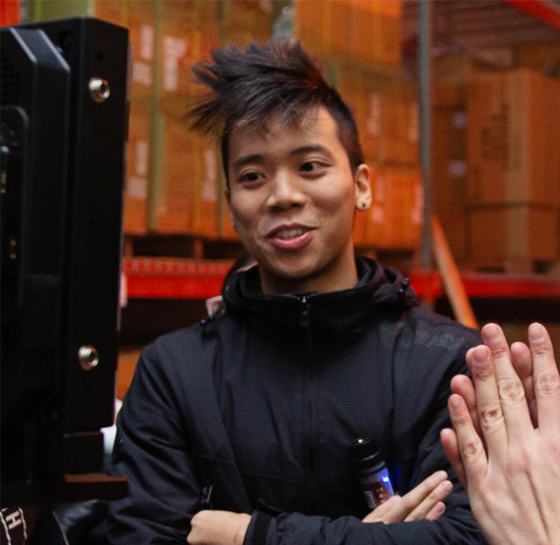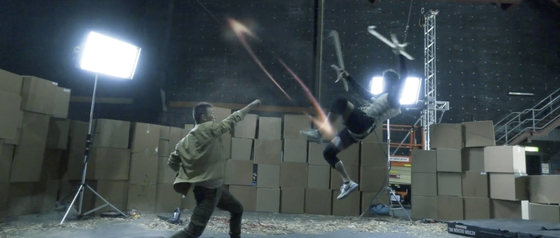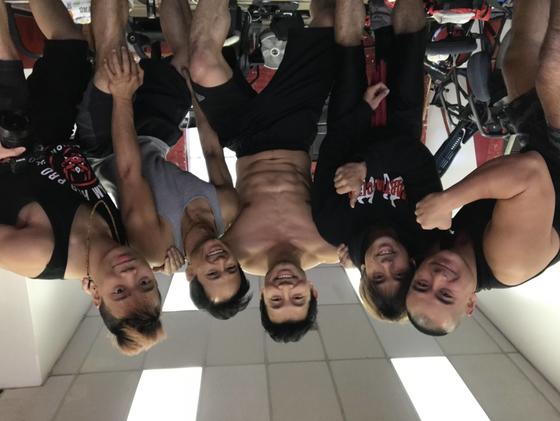Timing is one of the critical elements that students in the School of Art explore while they’re at Mason. If you wait to see how the light changes, or you make time to dig a little deeper about a subject, what does that change about your work? And when an opportunity presents itself, you learn to seize the moment and make the most of it, which could mean going from shooting your own films to working as an action designer on an international blockbuster with a legendary team.
Joseph Le (BFA in Graphic Design, 2012) knew that when he got the chance to work with one of his biggest idols in the film industry, there was no way he would let this moment go.

“I emailed Brad, just explaining that I loved his work, and that I wanted to help him showcase kung fu in a new light, while still respecting and honoring what has come before. And I included links to my three best films in the email, showcasing my camera work, my visual storytelling through action, and my visual effects,” said Le, of the email that would change his life.
Brad Allan, the legendary late 2nd Unit Director, stunt coordinator, martial artist, and veteran member of the Jackie Chan Stunt Team, replied to Joseph’s email saying, “How could I not hire you?!” Allan asked Le to come to Los Angeles to shoot “previs” or previsualization, for two weeks with Allan and the rest of the team who would be working on Shang-Chi and the Legend of the Ten Rings, the latest installment of the Marvel Cinematic Universe.
The journey from a graphic designer with a “9 to 5” office job to a film set on the other side of the world wasn’t a fast or an easy one for Le. Growing up in Fairfax, VA and living with his parents during college, Le wanted to major in film, but was worried that he should choose a traditional path that led straight into guaranteed employment after graduation. Knowing the demand for graphic design in the DMV, he thought that this was a surefire way to secure his future and keep his parents happy. He enjoyed his graphic design classes, furthering his understanding of impactful visual experiences and how to organize information.
During his junior year, Le took an animation class with Mason School of Art Professor Gail Scott White and found his passion for creating moving stories rekindled. He threw himself completely into his final project for the class, spending days rendering in the on-campus labs until late into the night.
Le believed it was too late in his college career to change his major, so he graduated in 2012 with a Bachelor of Fine Arts in Graphic Design and began working for a local company. Despite having a full-time job and plenty of time to spend with friends, Le was unable to dull the nagging feeling that he was denying himself the path that was in his heart. In order to scratch that itch, Le began helping out his film major friends on some of their own local shoots, learning from them and teaching himself animation on evenings and weekends. A devoted student of kung fu and martial arts since high school, Le wasn’t sure he should focus on those subjects in his filmmaking, but his friends encouraged him, saying that his deep knowledge of the subject would lend authenticity to his work. He used his company vacation time to do re-shoots with friends, and would fund his projects himself or through Kickstarter or GoFundMe campaigns he and his friends shared.
“I would be totally exhausted from my office job, downing Red Bulls at 8 p.m. and firing myself up with YouTube clips of Arnold Schwarzenegger speeches,” laughed Le. The long days and nights spent shooting, editing, and releasing short films of the test fights he was creating, which mixed different forms of martial arts using participants from local dōjōs, meant that Le could start submitting his films to different festivals, both in the D.C. area, like the 48 Hour Film Project, and via YouTube.
As Le’s style developed and his films gained more and more attention and positive accolades in the industry, he became part of the stunt communities in both NYC and LA. He is known for his anime style of action design, melding together hip hop and martial arts, best seen in his film “Afro Samurai Champloo.” Le went back and forth from LA to shoot for that film, working with friends in LA and then back at home in Virginia. It was one of these friendships that led to Le’s name being mentioned to the Shang Chi team, and his return to LA for advance work with them.

Fight Coordinator: Peng Zhang
Action Design by Joseph Le
Once on set, Le was excited to meet and get to know everyone, but noticed he wasn’t getting as much time behind the camera and shooting as he’d hoped. Rather than sit idle, Le started live storyboarding different ideas for the film’s action sequences on his tablet. Allan noticed and then asked Le to start creating specific storyboards for different fight sequences in the film, beginning with one that took place between Shang-Chi’s mother and father. As the work in LA continued, Le spent most of his time with one of the two teams who were shooting different sequences. Le and the team would film all day, with Le then editing the takes, and storyboarding more ideas for the next day – doing this every night until 2 a.m., then back up again at 6 or 7 a.m. to start all over again, getting 3-4 hours of sleep per night. At the end of the two-week period, Allan and the crew announced to Le “Congratulations, you passed the test” and booked him a flight to Sydney, where they spent the next four months working on the film itself. Le is credited as an action designer on the film, where he worked closely with an extensive team to conceptualize, create, and capture the work of the cast and bring it to the screen.
When asked if he felt unsure of himself to go from indie films to working on such an enormous and well-financed film, Le reflected, “You can’t go in intimidating yourself in that situation; there’s already so much at stake. I felt so lucky and told myself ‘I’m here because I’m valuable to them, yes, I’m learning and meeting everyone, but I’m also helping as I’m learning.” Staying focused helped to keep him grounded on set, where down time included grabbing Korean barbecue with the team and taking on star Simu Liu in games of Super Smash Bros.

Looking back, Le pointed out a moment that overtook his imposter syndrome, something he still struggles with today. When his first short action film went viral in 2015 (now with over 2 million views), comments flooded the page, saying they wished they saw this kind of work in Hollywood blockbusters. Seeing that kind of response from an audience, the connection between viewers and what is portrayed onscreen, fuels him to constantly get better. Even after this kind of success, he still shoots, tests, and edits ideas just for himself, to keep constantly learning. Now, he knows not every project is going to be perfect, and that “It’s ok to make something bad after making something good.”
Hoping to continue his latest streak of making something good, Le returned to the U.S. recently after spending five months working on a new live action anime film “Saint Seiya: Knights of the Zodiac” in Budapest, Hungary. His professional network has only grown and a feature film on a major streaming network is possible in the next year or two.
For current Mason students Le offers this advice, “Know that just because you started out in one field, it doesn’t limit you from exploring others. Make room for the things you are passionate about, and feed your time into them, even if you’re not sure yet where they’ll go.”
